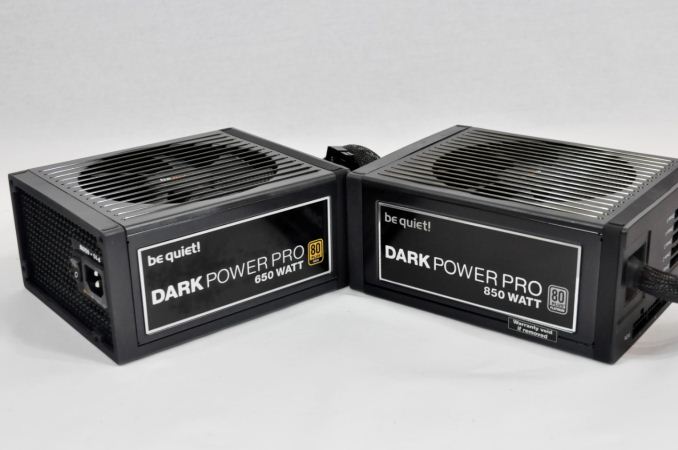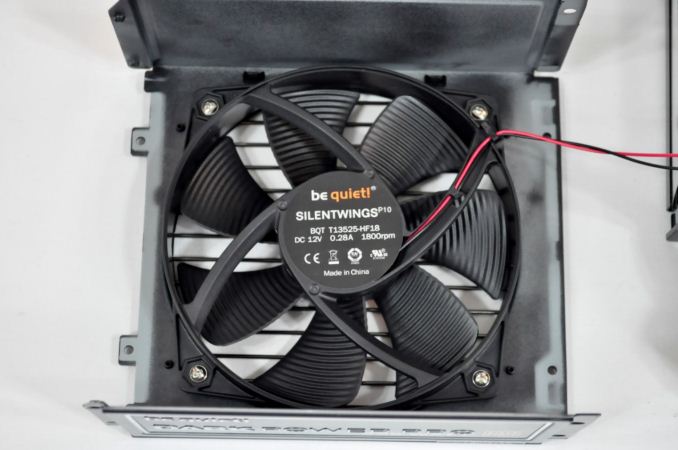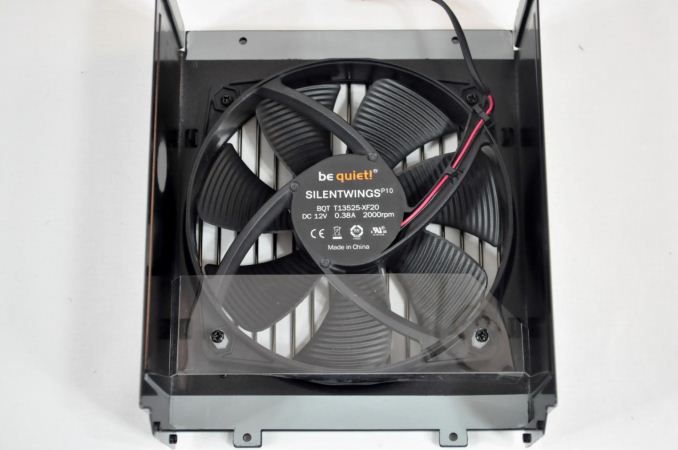Be Quiet! Dark Power Pro 10 650W & 850W PSU Review
by E. Fylladitakis on February 2, 2015 11:40 AM ESTExternal Appearance
Aesthetically, the Dark Power Pro 10 stands out from the crowd. The design of both the 650W and the 850W units that we received is nearly identical, with the only noteworthy difference being the depth of the chassis – the 850W version is 190mm deep, making it 10mm longer than the 650W version. Much like the Power Zone CM PSU that we reviewed a while ago, the fan guard is not a typical circular grill but an array of parallel wires. The main visual difference is that the Power Zone CM did not have decorative stickers covering the sides of the chassis.
There is a plastic frame at the back of the unit, adding a spacing between the case and the PSU for vibration absorption purposes. A rubber strip surrounds the front of the unit for the same reason. be quiet! installed an aluminum plate cover at the front of the unit, with a flexible rubber gasket covering the square hole of the only cable hardwired to the body of the unit. The sticker with the electrical specifications is on the top side of the chassis.
These enhancements however add bulk, making the 850W version of the Dark Power Pro 10 180mm deep, significantly deeper than a typical ATX PSU. The plastic frame at the front of the unit also pushes the opening of the cooling fan slightly backwards, even if only slightly. This could lead to the partial blocking of the opening by the case if the intake opening of the PSU compartment is not large enough, as many low-cost cases has openings barely large enough for the 120mm fan of an ATX-compliant (140mm) chassis. Users should ensure that their case can accommodate a PSU this long before buying.
Internal Design
Although both units are nearly identical visually, the 650W and 850W versions of the Dark Power Pro 10 are entirely different on the inside. That is true even for the cooling fan. Both units are using be quiet!'s own SilentWings P10 fans, but the T13525-HF18 and the T13525-XF20 are installed in the 650W and the 850W versions, respectively. Both fans utilize a fluid dynamic bearing, the same number of blades, and the same ribbed SilentWings fan design. The main difference is in their maximum current draw and, by extention, their maximum fan speed, though the difference is only 200RPM.
The cooling fans of the Dark Power Pro 10 650W (left) and 850W (right)
The Dark Power Pro 10 650W unit is based on an FSP (Fortron-Source) design. FSP is an OEM known for their good mainstream units but they are not really a supplier most companies prefer to use for their flagship series. be quiet! used the same OEM for their Power Zone CM series and that did not turn out so well. The Dark Power Pro 10 650W unit however is based on a more modern and efficient design. We found an acceptable filtering stage, comprised of four Y capacitors, two X capacitors, two filtering inductors, and a metal oxide varistor (MOV).
The presence of the MOV was a bit of a surprise – MOV's are commonly used for surge suppression but FSP rarely installs them into their units, declaring that the APFC stage is sufficient for this task. Two Matsushita 270μF/450V capacitors are present in the APFC stage, while the secondary capacitors are supplied by Nippon Chemi-Con and Rubycon (electrolytics), and CapXon (polymer).
From a technology perspective, the Dark Power Pro 10 650W unit is not very complex, with two transistors forming a half-bridge inversion stage and four transistors the secondary stage conversion stage, generating the 12V DC line. The 3.3V and 5V lines are derived from DC-to-DC conversion circuits present on the vertical daughterboard.
The 850W version is an entirely different story (and design). It is the only unit of the series with a core design coming from Seasonic, with be quiet! performing some modifications to match the features and visual appearance of the Dark Power Pro 10 series. The main modifications are the insertion of the OCK capability, the hardwiring of the 24-pin ATX cable, and the replacement of the fan.
The 850W model also has a stronger filtering stage, with a line filter on the AC receptacle and additional components on the main PCB. The entire filtering stage is comprised of six Y capacitors, two X capacitors, three filtering inductors, and a MOV. There are two primary conversion bridges bolted onto their dedicated heatsink. The blue 390μF/420V APFC stage capacitors are supplied by Hitachi, while all of the smaller capacitors, electrolytic and polymer alike, are supplied by Nippon Chemi-Con.
Four transistors form a full-bridge LLC primary inversion stage. The secondary conversion transistors are not mounted on the silver heatsinks but on the rear of the main PCB, partially cooled by indirect conduction via the PCB to the silver heatsinks and by the chassis itself acting as a huge heatsink for their cooling. Again, the 3.3V and 5V lines are derived from DC-to-DC conversion circuits, which this time are present on the PCB with the modular connectors. The PCI Express connectors are not present on this PCB and are installed on the main PCB, reducing the power that needs to be transferred between the main and secondary PCBs.































25 Comments
View All Comments
maeda_toshiie - Monday, February 2, 2015 - link
"CapXon is a reputable company and their polymer capacitors are among the best worldwide"????? You do know CapXon's reputation and its position in the cap quality rankings...?!
Tator Tot - Monday, February 2, 2015 - link
There's a large difference between Polymer Capacitors & Electrolytic capacitors; CapXon's reputation comes from the quality of their electrolytic capacitors, not their polymers. Polymer capacitors, in general, are pretty hard to mess up though. You'd really have to try to make bad poly's.E.Fyll - Monday, February 2, 2015 - link
Perfectly so. CapXon is one of the ten largest and most reputable companies worldwide. They do have a mediocre reputation, half due to a couple of bad series and half because their products were used in horrible designs, but claiming that they are bad when therea re three dozen worse companies, or trying to suggest that only Japanese companies make good capacitors (in Taiwan), is...not useful.dishayu - Tuesday, February 3, 2015 - link
I can't objectively comment on the quality CapXon capacitors, but i've personally had a poor experience with them in the past and if you google for CapXon you see nothing but criticism and poor reviews. They are very commonly called crapxon on the internet. I don't see how any of that equates to being reputable.4745454b - Tuesday, February 3, 2015 - link
I sort of learned this lesson with my Antec Smart Power 450W. (If you know caps, you know what was in that.) Once I figured out there was a possible problem with my PSU I did what I could to prevent it. I blew the dust out every three months, and kept the tower as a whole as cool as possible. Then I after a year or so I bought a better PSU, the EA500. I don't remember the system it powered back then, probably my E6600 and 7750. My roommate needed a PSU after I upgraded it and I stuck that in there telling her to be gentle with it. Her system was an old P4 with a 9800 I think. (ATI 9800, not Nvidia 9800.) She didn't listen and stuck her case in that sweat box some/most desks come with because "that's where the computer goes right?" Needless to say the PSU didn't last long.The point I'm trying to make is even bad caps can do their job if you are nice to them. And just because a cap doesn't come from X region doesn't mean it's bad.
shadowjk - Friday, February 6, 2015 - link
I'm not familiar with the reputation of individual manufacturers, but even assuming that every capacitor make and model meet their manufacturer's specifications, you can still end up with capacitor death.Capacitors have a defined expected lifetime, at a specific temperature, voltage, and ripple current. The "headline" ratings usually put you in the ballpark of a few thousand hours life expectancy, which is only slightly better than how long a classic light bulb lasts before burning out.
In a poor design, the voltage and temperature limits are usually met by the design, but ripple current spec is exceeded (if we presume the designer aimed for half decent usable life). Temp and V can be checked by average Joe user, ripple current is trickier.
I wonder if the "reputable" jp manufacturers have strings attached to sales, to make sure nobody blows up their capacitors...
extide - Monday, February 2, 2015 - link
Wow, that scope is pretty ancient and crappy! I mean, at least go for the Rigol DS1054Z -- twice the sample rate (max) and tons of features for a really great price.E.Fyll - Monday, February 2, 2015 - link
The scope is old but it is reliable and excels the required specifications....and I want a much better oscilloscope too, but things do tend to be more complicated when you actually have to pay for it.
jordanclock - Monday, February 2, 2015 - link
As someone that isn't particularly well versed in oscilloscopes, would a "better" model make a difference in the results of an Anandtech review? I know you all strive for the highest quality in your reviews, but is this an example of little return on investment?E.Fyll - Monday, February 2, 2015 - link
Not more accurate results on the current tests, but a better oscilloscope would allow for more tests. It will happen eventually but, with a price tag of nearly $9000, it will take a while.